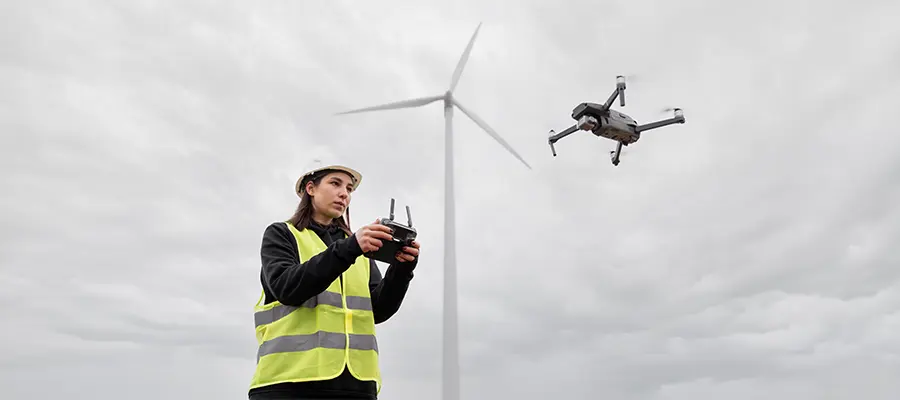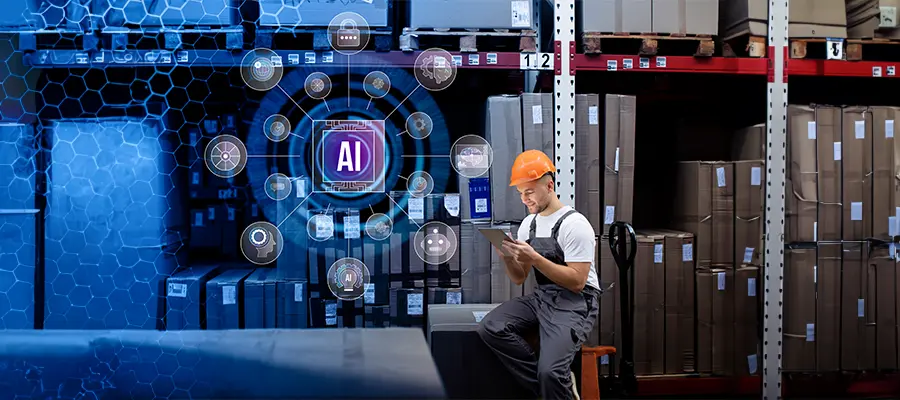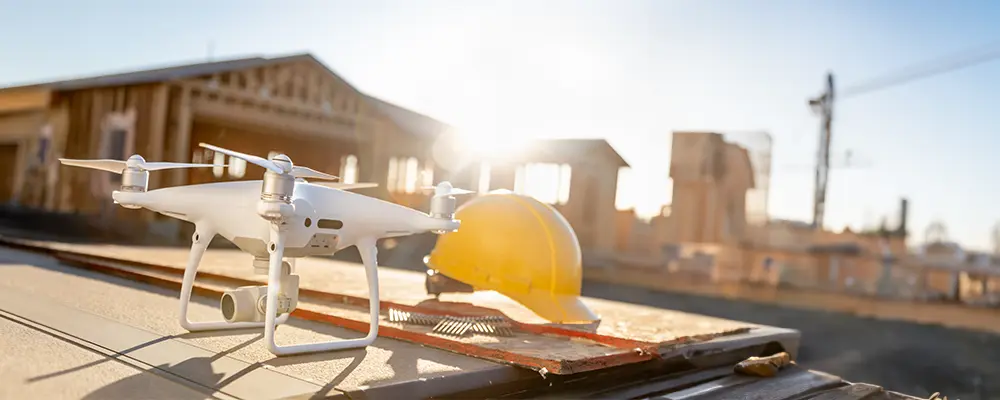Drones are the technology gaining centre stage in the fast-paced construction industry, where innovation redefines conventional procedures. Unmanned Aerial Vehicles (UAVs), also called drones, are transforming the construction sector with a wide range of uses, including mapping, surveying, and inspection.
This blog, Brick & Bolt, delves into the revolutionary effects of drones in the construction sector, highlighting their many uses, advantages, difficulties, and potential future.
The Rise of Drones in the Construction Industry

1. Surveying and Mapping:
Traditional Challenges: Difficult terrain can make traditional surveying and mapping methods more difficult and necessitate time-consuming procedures. Accurate data collection for ground-based surveys may require assistance, particularly in remote or extensive locations.
Drone Solutions: Drones with LiDAR sensors and high-resolution cameras provide a quick and precise substitute. They can cover large areas quickly and effectively, supplying specific topographical data for volumetric measurements, design planning, and site investigation.
Advantages:
Quick data collection: Using drones drastically reduces the time needed to examine significant areas.
Enhanced accuracy: LiDAR technology provides accurate topography data and high-resolution images.
Enhanced safety: Removes the need for surveyors to navigate rugged terrain or dangerous areas.
2. Construction Site Monitoring:
Traditional Challenges: Project management depends on monitoring building sites to ensure that plans are followed and there are no possible problems. Access constraints and the inability to collect data in real-time may be the limits of traditional site monitoring.
Drone Solutions: Monitoring construction sites to ensure that plans are followed and there are no potential issues is essential to project management. Traditional site monitoring may have limitations due to accessibility issues and the inability to gather data instantly.
Advantages:
Improved project visibility: Up-to-date aerial photos ensure a thorough understanding of the building site.
Better project management: Makes it possible to make decisions quickly using the most recent data.
Monitoring progress: This enables effective monitoring of building schedules and milestones.
3. Building Inspection and Maintenance:
Traditional Challenges: Inspecting buildings, bridges, and other structures for upkeep or safety inspections can take much work, mainly when working with tall or intricate constructions. Conventional techniques could entail hazardous manual examinations or pricey equipment.
Drone Solutions: Drones with cameras and sensors can take high-definition photos and navigate intricate constructions. They are beneficial for performing considerable manual labour or scaffolding-free roof, facade, and other hard-to-reach area inspections.
Advantages:
Increased safety: Manual checks are necessary for less dangerous risks, particularly at high heights.
Cost-effective: Compared to conventional inspection techniques, drones are a more economical option.
Thorough data collection: A thorough investigation of structural problems is made possible by high-resolution images.
The Advantages of Drones in Construction
1. Time and Cost Savings:
Swift Data Collection: Drones expedite data collecting procedures, reducing the time required for mapping, surveys, and inspections. Efficiency means that projects can be finished faster and with fewer resources, which results in cost savings.
Decreased Downtime: By enabling construction managers to quickly detect and resolve problems, drones’ real-time monitoring capabilities help to minimise downtime. Aerial insights can be used to inform timely interventions that keep projects on schedule and minimise delays.
2. Enhanced Accuracy and Precision:
Drones equipped with sophisticated cameras and sensors can obtain high-resolution footage, which is helpful for mapping, surveying, and inspections as it provides precise and comprehensive data. This precision improves the total accuracy of construction operations.
Data Integration: Building Information Modeling (BIM) software and other construction management systems can easily include the data gathered by drones. This connection guarantees that all project participants have access to the most accurate and up-to-date information.
3. Improved Safety:
Reducing Risks: By eliminating the need for physical inspections at heights or in dangerous situations, drones help to improve safety on construction sites. By doing this, the risk to employees is reduced, and job site safety is improved overall.
Enhanced Emergency Response: Drones can quickly examine affected areas from the air during emergencies or natural disasters. This ability to act soon helps with disaster relief and makes emergency interventions more effective.
4. Flexibility and Accessibility:
Navigating Challenging Terrains: Drones can get through rugged terrain, giving them access to places that could be unsafe or difficult for ground-based surveys or inspections. This adaptability is extremely valuable for building projects with a variety of terrains.
Scaling Heights: Drones are excellent at reaching heights that would generally require specialist equipment or a lot of manual labour for examining large buildings like skyscrapers or bridges.
Challenges and Considerations in the Integration of Drones:
1. Regulatory Compliance:
Regulations for Navigating Airspace: Different national laws apply to the usage of drones. When implementing drone technology, building organisations must carefully evaluate how to comply with aviation authorities, navigate these rules, and secure the required permits.
Privacy Issues: Using drones presents privacy issues, particularly in urban settings. Building businesses need to set up explicit procedures for gathering data and handle any privacy concerns that may arise from employing drones.
2. Technical Challenges:
Battery Life and Range: The battery capacity of a drone determines its flight time and range. Large-scale construction projects may require long-range drones or repeated drone flights to achieve thorough coverage.
Weather Conditions: Unfavorable weather conditions, including strong winds or heavy rain, might affect how well drones operate. Weather-related restrictions must be considered for construction projects in places with unpredictable weather patterns.
3. Skill Requirements:
Operational expertise: Skilled pilots who comprehend the unique demands of construction applications and the technical facets of drone operation are necessary to operate drones in the construction industry efficiently. For drone operators, certification and training are prerequisites.
The Future of Drones in Construction:
1. AI and Automation:

Autonomous Flight and Navigation: Drone autonomous flying and navigation are becoming possible due to developments in artificial intelligence (AI). Artificial intelligence (AI)-enabled drones can optimise flight routes, navigate construction sites, and carry out tasks without continuous human supervision.
Automated Data Analysis: Drone data can be automatically analysed using analytics driven by artificial intelligence. This entails finding trends, seeing abnormalities, and producing insights that can be put to use without the need for human interpretation.
2. Integration with IoT and Sensors:
Drones can be equipped with various sensors, such as environmental monitors, gas detectors, and thermal cameras. Thanks to this connectivity, they can offer a wider variety of data, which helps with applications like safety inspections and environmental monitoring.
IoT Connectivity: Drones on building sites can interact with other equipment and systems by being incorporated into Internet of Things (IoT) ecosystems. This connectedness improves the total effectiveness of data collecting and processing.
3. Beyond Visual Line of Sight (BVLOS) Operations:
Extending Operational Horizons: Drone missions classified as Beyond Visual Line of Sight (BVLOS) do not necessitate the pilot to keep visual contact. Drones can cover more significant areas through BVLOS operations when restrictions change, increasing their impact and reach.
4. Swarm Technology:
Collaborative Drones: Swarm technology refers to the synchronised movement of several drones cooperating to complete tasks. With drones cooperating to cover vast areas, this cooperative strategy could improve the productivity of large-scale construction projects.
Drones are influencing a new era of construction techniques, ranging from monitoring and surveying to inspection and maintenance. The industry is overcoming obstacles, including technical constraints and regulatory compliance, while embracing drones, which promise to provide new efficiencies and capabilities.
The construction sector is changing because construction companies use drones to reach new heights. The sky is becoming more than just a background; it’s a dynamic frontier where creativity, technology, and construction combine to create a future of never-before-seen possibilities. Greetings from the age of drone construction, where each mission brings us one step closer to revolutionising how we make, plan, and imagine the buildings that define our surroundings.

